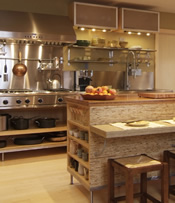
When clients tell me they have been visiting kitchen showrooms to get some inspiration for a kitchen remodel, I caution them to stop before they shop. The kitchens displayed in showrooms have two problems: One is that they are usually built on one or two walls and are missing the essential four walls that really define a space. Secondly, they are not necessarily the kind of kitchens people need today. In fact, traditional kitchen design has not changed since the 1940s when the room was designed around the so-called Kitchen Triangle — touted as the golden rule in kitchen design — and defined by the placement of the stove, sink and refrigerator in close proximity to each other. It was a design that was well-suited for the era of the stay-at-home mom, when only one person was cooking for the family.
But as we all know, times have changed. Most kitchen designs have not.
Today, the elements of an old standard kitchen design do not take into account the modern lifestyle: busy mornings, jam-packed evening meal preparations (with side orders of homework), and families that cook together.
We believe in kitchen design where all functions can take place simultaneously with the least amount of overlap. The principle we work from is really quite simple. We call it Function Centers© and it is based on the notion that similar cooking functions can be performed in several places in the kitchen complex.
Some of the hallmarks of this design include:
- The elimination of what we call non-working corners; those interior counter corners that have an appliance, wall, or door placed less than 24 inches away, which makes it impossible for two people to occupy the area without butt-bumping.
- Multiple work stations. Instead of just one sink, there may be two sinks: one for chopping and food prep; the other for the traditional dish and pot washing. We may have two refrigerators, a large traditional one and a small one for cold beverages, milk, etc. We may design two separate heating centers – one for hot beverages and quick toasting, etc., and another for the full-size stove and oven.
- Sensible oven and cooktop placement. Oven cooking is usually unattended (isn’t that the whole point of using an oven?) so why give it prime real estate? We often see ovens and cooktops placed smack up against a door opening. Not only is this a poor use of space, but it is also dangerous, since nothing is more conducive to head injuries or burns than for a kid to tear through the door just as the oven is opened or the boiling pot is lifted off.
- Spacious countertops. Our kitchen designs not only provide ample counter space on both sides of cooktops and sinks, but we also recommend at least 40-48 inches between the main work counters. This makes a smoother flow for the cooks so they can slip by each other gracefully.
- An open space plan which allows visibility from the functional part of the kitchen into the main eating area.
While it is easy to get caught up in the allure of shiny new appliances and rich new cabinetry, a truly successful kitchen remodel is one that is based on effective space planning. Given the amount of time we spend in our kitchens and the central role they play in nourishing the physical and emotional needs of our families, a kitchen should be customized to reflect the needs of a particular family, not the “one-size-fits-all” approach of a kitchen showroom.
